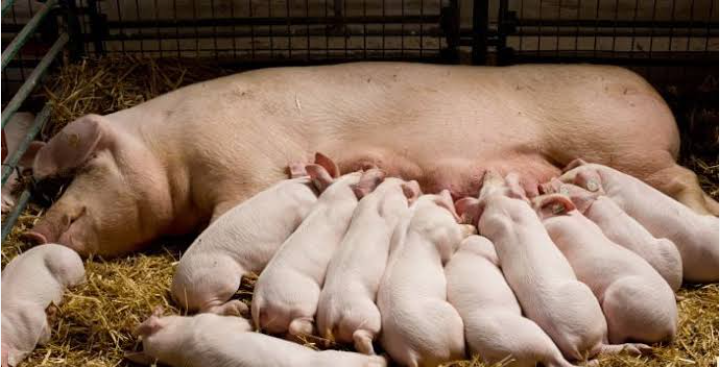
Fig 1: SOW WITH IT’S PIGGLET
Piggery
Pig farming also called piggery or pork farming or hog farming or swine farming is the raising and breeding of domestic pigs as livestock. Pigs are Non ruminant animal and highly prolific. An adult male pig is called Boar.
Sow: An adult female pig that has given birth at least once.
In-sow: A pregnant female pig,
Barrow: A male pig castrated before reaching sexual maturity,
Gilt: A young female pig that has never given birth
Piglet: A very young pig that is between 1-30 days old
Weaner: A very young pig that has been removed from the mother,
Runt: A weak or small pig in a litter
Wallowing: The act of taking a bath in a water-filled container or depression.
Pigs are farmed principally for food (e.g. pork: bacon, ham, gammon) and skins.
The domestic pig (Sus domesticus) is given the scientific name Sus scrofa domesticus, although some taxonomists, including the American Society of Mammalogists, call it S. domesticus, reserving S. scrofa for the wild boar. Typically, pig have a large head with a long snout that is strengthened by a special prenasal bone and by a disk of cartilage at the tip. The snout is used to dig into the soil to find food and is a very acute sense organ. The foot has four hoofed toes. The outer two are used in digging soft ground. The dental formula of adult pigs totals 44 teeth. The rear teeth are adapted for crushing. In the male, the canine teeth form tusks, which grow continuously and are sharpened by constant grounding against each other. The tail is short and they love wallowing. They have high fatty layer underneath their skin.
BREEDS OF PIG
All pig breeds are generally considered to have originated from the wild boar. European wild boar (sus scrofa ferus) and the Asian wild boar (sus indicus)
There are many breeds of PIGS. There is the local breeds and exotic breeds. The West African dwarf breed is the only local breed in Nigeria apart from the exotic breeds. For commercial farming, exotic breeds of pigs is recommended due to their preferred characteristics.
CHARACTERISTICS OF EXOTIC BREEDS OF PIGS
1. They are bigger in size
2. They are highly prolific
3. They weigh more than local breeds
4. Produce more pork than local breeds. Breeds like Yorkshire/Large White and Landrace produce meat suitable for the production of processed food (sausages).
5. Command more income than local breeds etc
6. Yorkshire/Large White and Landrace are used for genetic improvement programmes
The following are the recommended exotic breeds with their characteristics:
Large White
Landrace
Duroc
Poland China
Tamworth
Yorkshire
Hampshire
Crosses of the above
1. Large White Yorkshire: It is the Heaviest breed of all pigs. It is a large, long, white pig with compact body. Head is moderately long with slightly dished face. Skin is pink in colour and free from wrinkles. The females are highly prolific, good mothers and milkers. Mature boar and sow weighing about 300-400 and 227-317 kg respectively.
2. Berkshire:
It is characterised by its short and upturned nose. It is a medium sized animal, black in colour with six white points, on the feet, nose and tail
3. Tamworth:
The Head is long and narrow with long snout and erect ears. It is a docile pig with golden red colour which varies from light to dark. They are good for bacon production. The sows are prolific and the pigs are excellent foragers, which make them suitable for low input production system
4. Landrace
This breed is white in colour and characterized by long, deep side, square ham, relatively short legs and heavy top ears. It is the Highest producer of good quality bacon in the world. The caot is White in colour with some black skin spot known as freckles. Mature boar weighs 270 – 360 kg and the sow 200 – 320 kg.
5. Duroc:
This breed has moderately red coloured coat with shades varying from golden to cherry red colour. It is a large breed with excellent feeding capacity and prolificacy. They are hardy and capable of growing at a faster rate.
6. Hampshire
They are characterized by its black color with a white belt around the fore quarter of the body. The body is elongated, well-muscled, clean cut, firm and solid with erect ears. They are medium sized, prolific, good nursing mothers and efficient converters of feed. Hampshire sows, under well managed conditions, produce up to 2 litters per year with an average litter size of 8 at weaning
7. Chester White
the breed is white in color. Sow are excellent mother and prolific. The pigs are good feeders, mature early and make good gains.
The local breed of pig called the West African Dwarf Pig is smaller and less productive than the exotic breeds.
ADVANTAGES OF REARING PIGS
1. Pigs can convert edible feeds, forages, grain byproducts and garbages into valuable nutritious meat.
2. Pigs grow very fast
3. Pigs are highly prolific. Their gestation period is 114 days ( that is, 3 months, 3 weeks and 3 days). They farrow between 10 to 12 piglets at a time. And two litters per year.
4. The return on pig rearing is high. With little investment, the income from pig product is high.
5. Pigs feaces are good source of manure for improving soil fertility.
STARTING A PIG FARM
For commercial farmers, starting a pig farm require the following steps.
1. PURCHASE OF PIG: Farmers should purchase purebreds from a reputable breeder who keep good records of his stocks.
2. HOUSING: New pigs should be kept in a stall or safe quarters to prevent them from predators and observe the closely for at least 4 to 6 weeks. The floor of the house should be covered with woodshavings. Piglets should be given iron injection. After the 4 to 6 weeks, they should be moved to their new pen. Boar should be separated from gilts to prevent breeding.
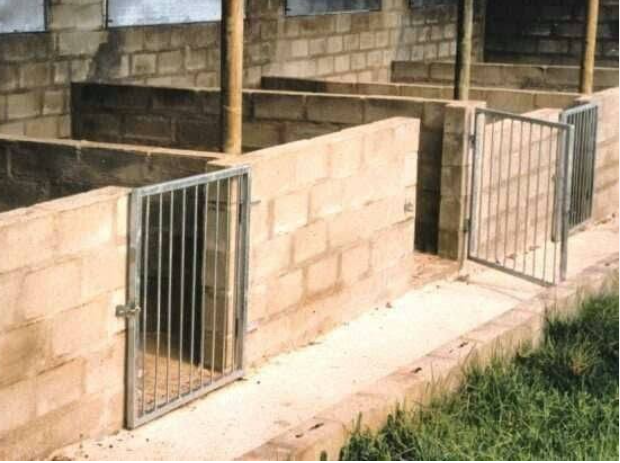
Fig 2: PIG PEN
3. FEEDING : Pigs need constant supply of fresh water. Feeds like kitchen scraps, forages, grain byproducts, and compounded feeds can be fed to them. A well balanced diet should be given at their different stages of age. Young pig diet should contain about 20% protein. Above 20% protein can harm the piglets.
4. DEWORMING : Pigs are easily infested by internal and external parasites. Therefore, deworming should be carried out occationally (especially every 6 Months). And external parasites treated.
6. BREEDING /REPRODUCTION : Pigs are ready for mating by 6 month of age. Their gestation period is 114 days and can farrow twice in a year. Sow ready for breeding should be properly feed with balanced diet( flushing). And also when a month before giving birth.
7. RAISING PIGGLETS:
New piglets need proper care. They need their mother or a sorogate mother to feed them with milk. Iron injection should be given to the piglets to protect them from anaemia. After 8 to 10 weeks, the piglets should be weaned from the Sow.
PIG PRODUCTION SYSTEMS
There are three management systems in which pigs can be raised or kept. Similar to poultry, cattle and other livestock animals, pigs can be raised under:
Extensive or Free-range system
Semi-intensive system
Intensive system
EXTENSIVE OR FREE-RANGE SYSTEM
This is a system in which the pigs are allowed to move around without limits or unconfined. The animals find and scavenge for food themselves while the farmer supplements this with agricultural byproducts or kitchen waste. In the evening, the pigs return to the enclosure made for them as SHELTER. The pigs mate indiscriminately. The farmers keep the pigs as a regular source of income or meat production.
The local pig breeds are usually kept in this system because they have high resistance to diseases and can manage with low-quality food/feed. One of the advantages of this extensive system is that little, or no money is spent in providing food or veterinary services for the pigs
2. SEMI-INTENSIVE SYSTEM
The Semi-intensive system involves confining the pigs to limited space or area. Both the Extensive and Intensive systems are combined to form a single system. The farmer provides all the feed, water and veterinary services that the animals need because they are not allowed to scavenge or find food and water for themselves. So the pigs are feed with kitchen wastes and agricultural byproducts such as corn husks and cobs, cassava peels, yam peels, etc. Under this type of management system, the pigs are allowed to graze on grasses within the confined space. The pregnant sows are usually given special attention and provided with extra food.
3. INTENSIVE SYSTEM
The intensive system is the best and recommended system of keeping pigs if the production goal is to generate income. Under this system, pigs are kept indoors or in pens and not allowed to move out of their confinement . The pens are constructed in such a way that the pigs can eat and drink in their pen. This is the type of management system practiced by commercial pig farms.
CONSTRUCTION OF PIG HOUSE
The construction of pig house is different from that of other livestock.
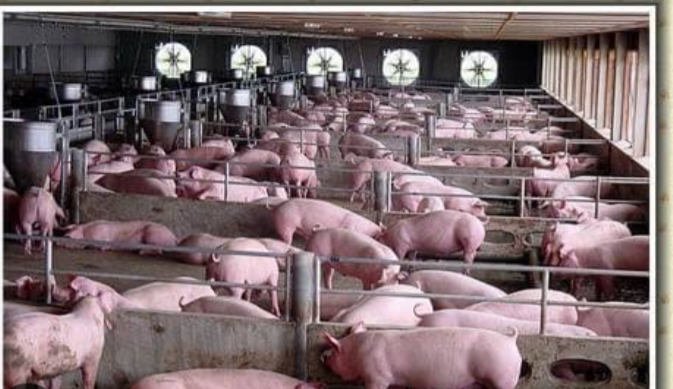
Fig 3: MODERNISED PIG HOUSE FOR COMMERCIAL FARMING
1. The Roof
The roof should be constructed using a corrugated roofing material that insulates excellently against cold and heat. And trees should surrounding the pens. The roof must be sloppy to allow down flow of rain water
2. The Floors : The floor should be slightly elevated above the surrounding floor. It should be slopy in order to prevent flooding of the pen with wastewater and easy run-off.
Drainage system should be constructed so that faecal manure and wastewater can be collected easily into a sewage pit.
The floor should be well concreted, hard but not too smooth to prevent slippery and make floor cleaning easy. A run (dung area) should be provided in the pig pen to defecate.
The Pigs pen should be clean, feeding trough and inbuilt water troughs; a resting area with adequate ventilation; and excreting area (run) where they will excrete should be provided to maintain good hygiene of the pig
3. The Walls
The construction of the pen walls of the pig house depend on the climate of the area. In Nigeria, the walls of a pig house should be low and left opened so as to give room for adequate ventilation. The height of the wall should be 1.2 metres while the distance between the wall and the roof should be 1 metres.
Brick and cement should be used in constructing the walls because it is stronger and last longer even though they are costlier. Cement and brick walls are easy to clean and maintained, and they make a pig house look great. Use of wooding materials should be avoided because the pigs can feed on it.
4. THE PEN:
The feed trough should be inside the pen and can be made of cement, or iron. The feed trough should be long enough for all the pigs in the pen to feed on it all at once. Fatteners need a feeding space of 30 cm each while sows need a feeding space of 40 – 50 cm each.
The water trough also should be constructed in the pen. It should not be so wide, else the pigs will bathe in the trough. You can prevent this by fixing an iron bar across the water trough.
Avoid keeping pigs of different sizes or ages in the same pen. The stronger ones may bully or bite the weaker pigs when there is inadequate feed to eat. So the stronger pigs get fatter while the weaker pigs get leaner.
Regular cleaning of the pen should be done or else, the pigs will wallow in their urine and faeces.
Pregnant sows need a quiet environment. Therefore individual pens should be used for pregnant sows.
Lactating sows also need a quiet environment. Therefore individual pens should be used. There should be provision for; farrowing pan, heating and cooling arrangements, Piglet nest/ box, creep feed /starter feed for piglets.
Sow should be prevented from escaping to the gilt and Sow on heat pens. Therefore metal doors should the used for their pen
MANAGEMENT OF PIGLETS
After newborn piglets are born, their navel should be soak the in iodine solution to prevent inflammation (omphalitis). The piglets should also be aided by putting them onto the udder of their mother. They need to suck from the colostrum (first milk) which helps in fighting impending diseases.
The Young piglets tend to be anaemic (have a shortage of iron in their blood). Piglets suffering from anaemia become pale and their growth rate drops. iron injection (Iron D) at the age of 1 – 3 days should be given
Some important operations carried out on piglets are:
Teeth trimming
Castration
Weaning
1. Teeth Trimming
The creep teeth of piglets should be trimmed or removed as they can use these teeth to injure each other or damage the teats of their mother. A drill, hand file or hand plier can be used to remove these creep teeth.
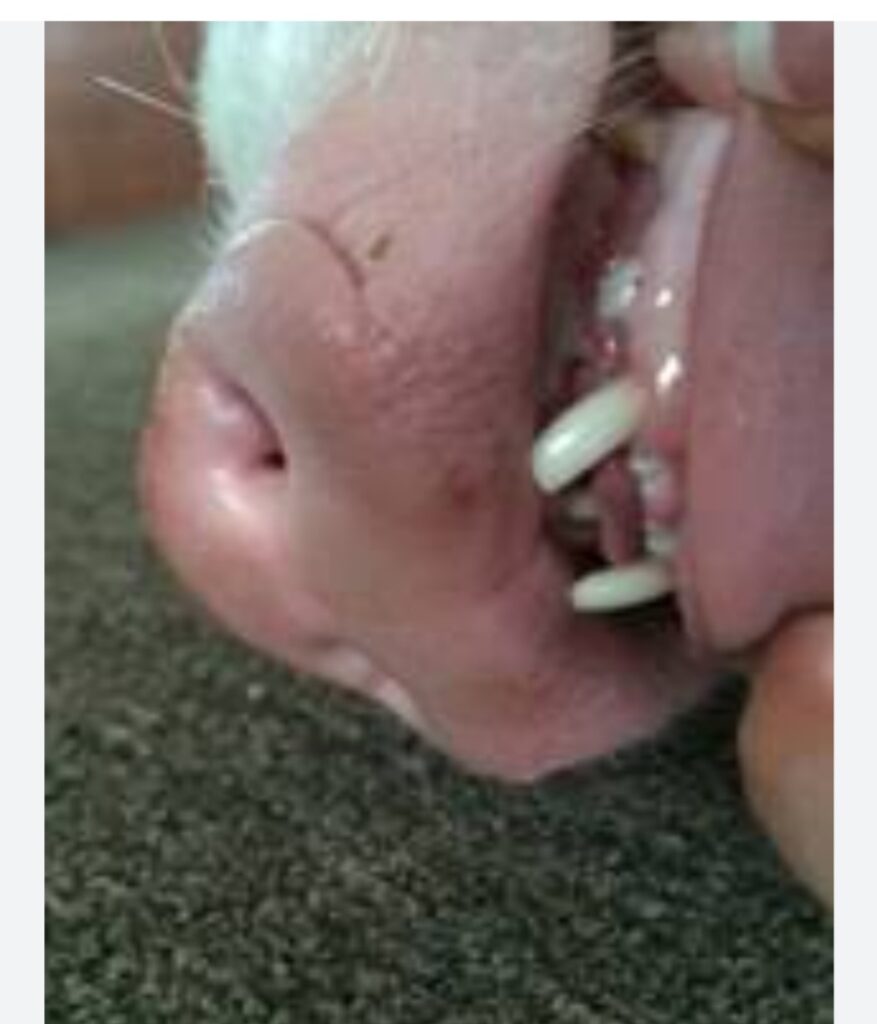
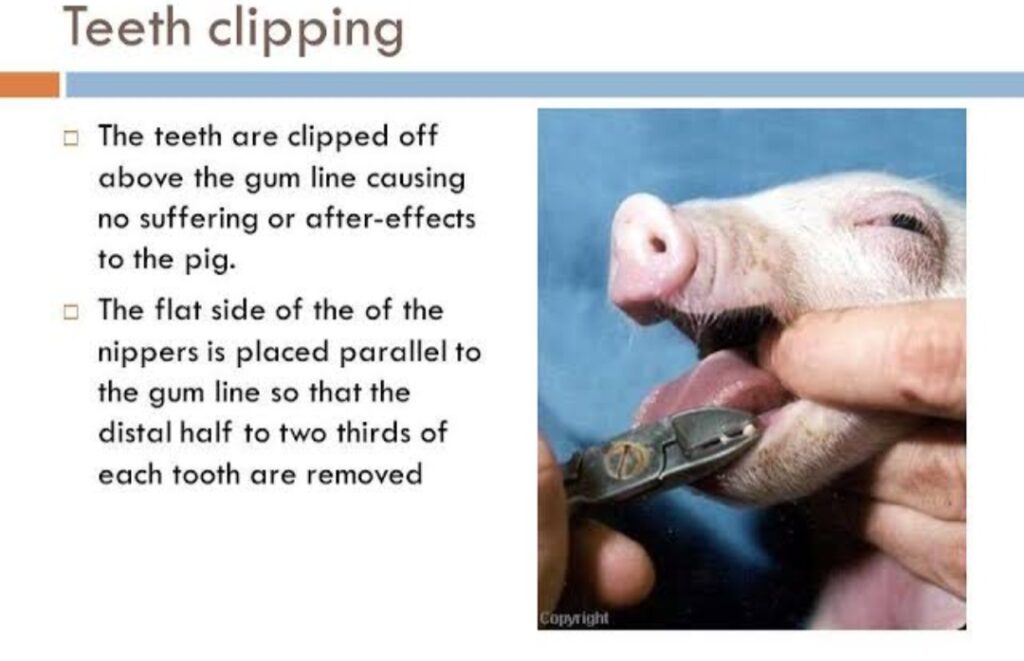
2. Castration
To prevent the meat of male pigs from tainting by an unpleasant smell, they have to be castrated. Castration also helps in increasing feed conversion to meat (pork). Castration should be done when the two testes have descended into the scrotum.
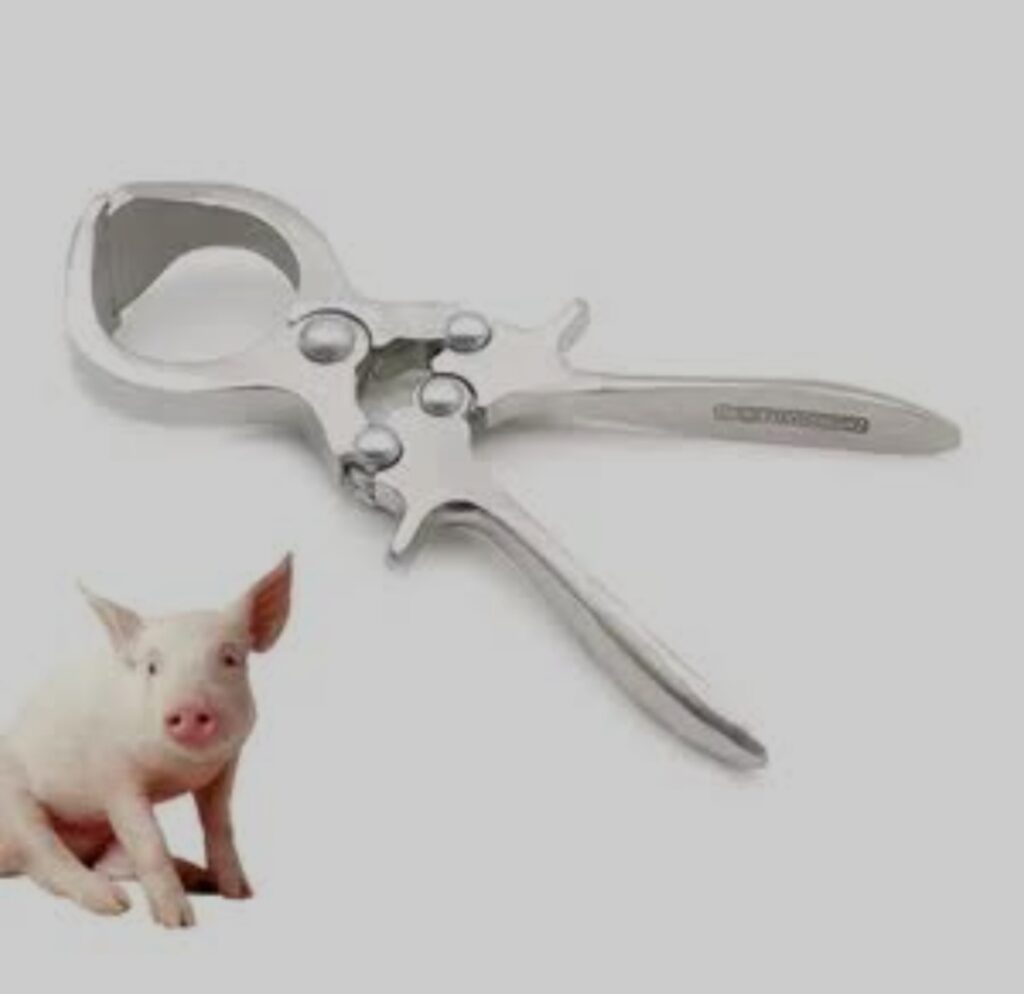
3. Weaning: This is the separation of the piglets from the Sow between 4 to 8 weeks. The piglets are fed with creep feed and clean water. Castration and teeth clipping can be done at this stage.
PIG NUTRITION
in pig farming, nutrition is very vital. Pigs can consume everything that humans eat. They are omnivores; that is, they can feed on food from both vegetable and animal origins. For pigs to perform better, they need to be fed balanced diets and in adequate quantities. Pigs can eat kitchen wastes, edible vegetables, farm by-products such as cassava peelings, yam peelings, maize cobs, etc. Nevertheless, they perform much better on concentrates.
PIG DISEASES
Pig diseases in the pre-weaning stage
1. Exudative dermatitis (greasy pig disease):
This disease is caused by an infection with the Staphylococcus hyicus bacteria and it manifests through skin lesions. Mortality can occur due to greasy pig disease in severe cases that are left untreated. The lesions first appear as dark spots on the skin, which spread and become flaky, with a greasy feel.
PREVENTION : The infection is treated with antibiotics, skin protectants, and autogenous vaccines. One of the best prevention methods is to improve hygiene conditions in the piglet housing areas
2. Coccidiosis
Coccidiosis is very common in suckling pigs, being caused by three types of the coccidia intercellular parasite. The main symptom is diarrhea, which can also be bloody and it occurs during between 10 and 21 days of age and up to 15 weeks of age.
TREATMENT : Acute cases can be treated with coccidiostats and fluid Therapy.
3. Respiratory diseases
The most common symptoms of respiratory diseases are coughing, sneezing, heavy breathing, reduced growth, and even mortality. ,
.TREATMENT : antibiotics are often given in feed or water or as injectable substances.
4. Swine dysentery
Pigs that suffer from dysentery have diarrhea, with or without the presence of blood. This disease is caused by the bacteria Brachyspira hyodsenteriae. Pigs that suffer from dysentery in the post-weaning stage have reduced growth rate; in more severe cases sudden death can occur.
TREATMENT : antibiotics which are given through feed or water, or as injectable substances.
Pig diseases in the breeding stage
5. Mastitis
Mastitis is a disease present in sows and it has symptoms such as reduced milk production, higher body temperature and loss of appetite. The disease is caused by a bacterial infection of the mammary glands, where skin discolorations can be observed.
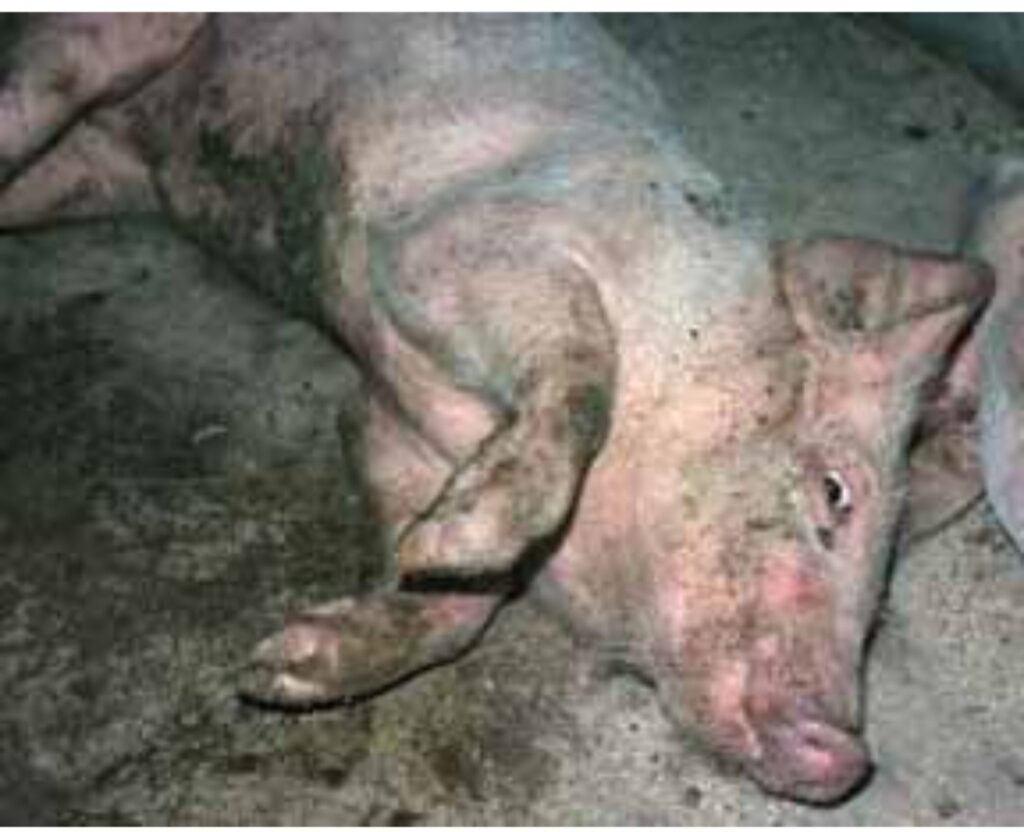
TREATMENT : Antibiotics and anti-inflammatory Drugs should be given
6. Porcine parvovirus
Pregnant sows can become infected with the parvovirus (PVV) and in some cases, reproductive diseases can occur. Usually, the reproductive disease occurs in gilts, the reproductive performance being overall affected. Pig litters are decreased in size because of stillbirths and mummification. The parvovirus is somewhat more difficult to diagnose because other reproductive diseases present similar symptoms. The virus can survive outside its host for several months.
TREATMENT : regular vaccination of gilts
Other common pig diseases
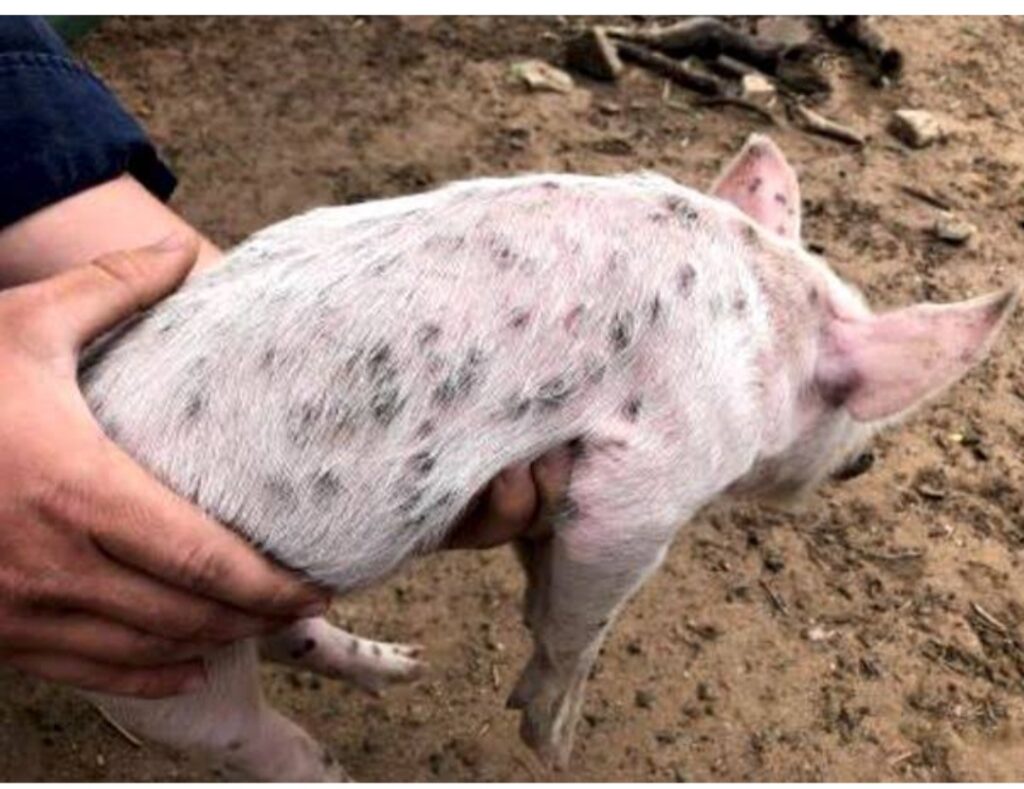
7. Salt poisoning: Salt poisoning occurs because of improper feed. Pigs fed with restaurant leftovers or with food leftovers from various sources may contain too much salt. Pigs affected by salt poisoning appear to be blind, they lose their balance and fall over, they vomit and have seizures. .TREATMENT : Give quality feed to the pigs.
8. African swine fever (ASF): African swine fever is caused by the Asfarviridae family of viruses, which are distinct from the viruses associated with classical swine fever. The ASF infection can occur in several ways: contaminated feed, tick, and lice bites, contaminated medical equipment and infected pigs. Treatment: There is no treatment for the African swine fever or a live or attenuated vaccine to prevent this disease, therefore strict biosecurity measures are the only ways to prevent infection and the spreading of infections. Infected animals must be isolated and culled immediately if the presence of the virus is confirmed
9. Foot-and-Mouth-Disease (FMD)
FMD is caused by a picornaviridae aphthovirus. The symptoms of FMD include lameness, excessive salivation, blisters, loss of appetite, fever, and death in severe cases.
TREATMENT : Routine Vaccination. There is no treatment for this disease and infected animals should be culled.
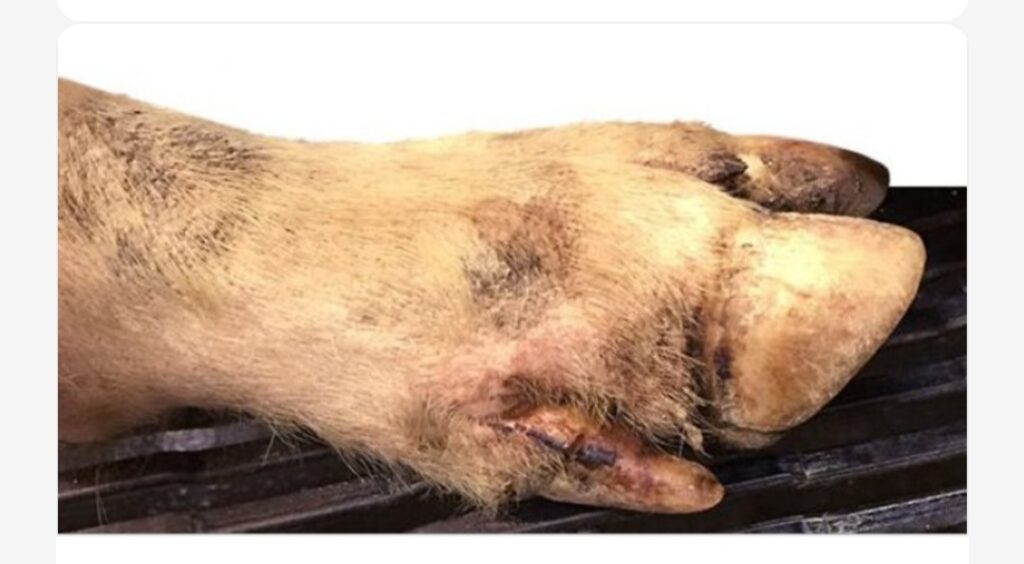
PEST
1. Lice and flies
lice and flies infestations pose a serious health threat in pig farming . Pig lice can cause blood loss and the infection with bacteria. Flies can also be a problem because they enter open wounds and cause infections.
PREVENTION :Both lice and flies can be treated with sprays. Ensuring proper hygiene in the housing areas, using fly traps and flypaper can prevent infestations.
2. Parasites
Roundworms are the most common parasites found in pigs. They live in the gut and cause weight loss. Young pigs present the highest risk of infestation. Roundworms can block the gut and cause death. Even if the pigs survive, if the parasites are not eliminated, the pigs’ growth is permanently reduced.
TREATMENT : The parasites are eliminated with dewormers
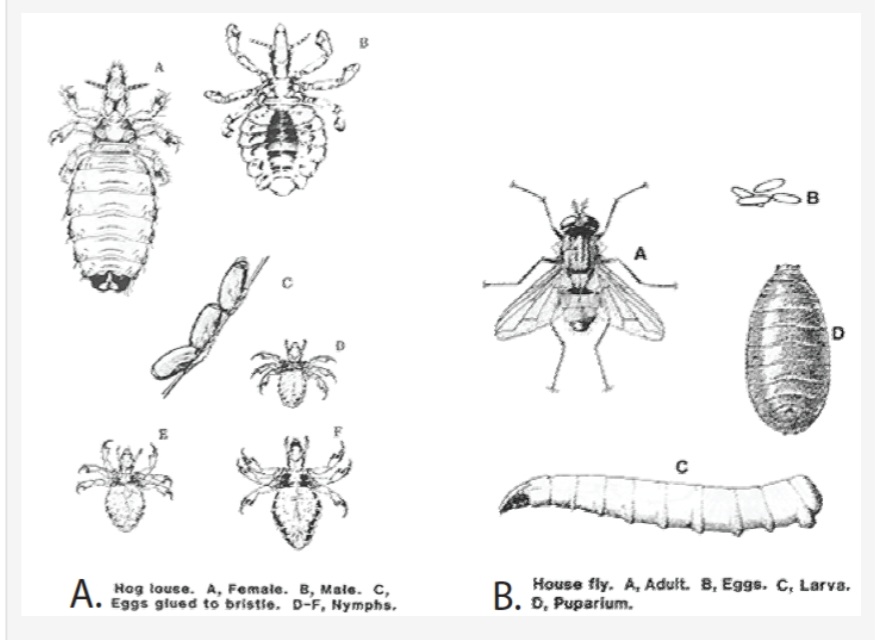
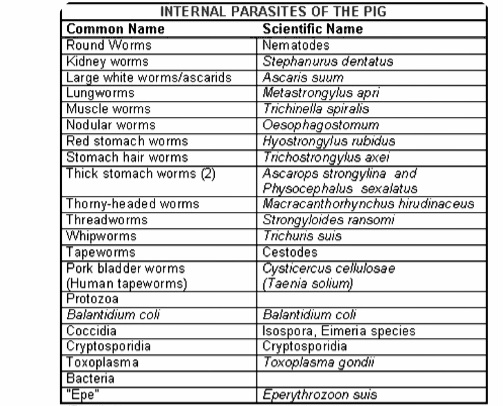
3. . Tapeworm : These parasites live in the muscle of the pigs and cause pig measles. The pigs experience pain and have difficulties to move around. Pig meat infected with tapeworms is very dangerous for human consumption. Undercooked infected meat contains tapeworm cysts, which develop into worms in the intestines and cause serious health problems.
TREATMENT : farmers should practice good hygiene and stopping pigs from wandering around outside from the farm.
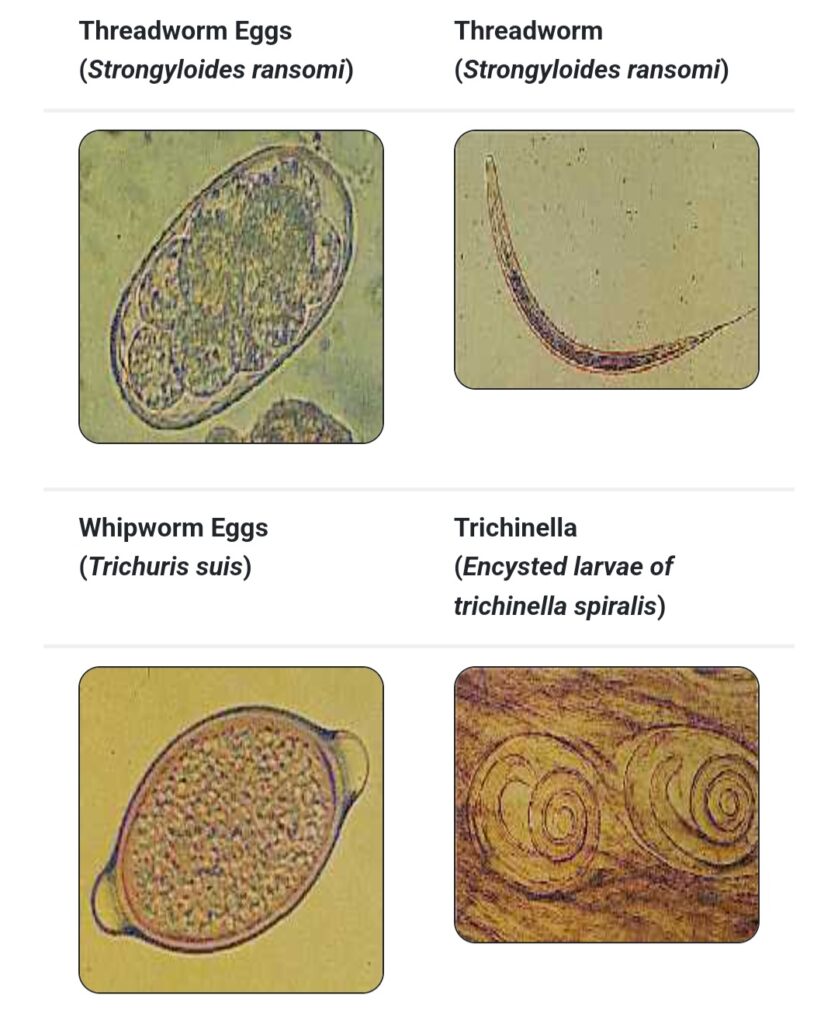
.
